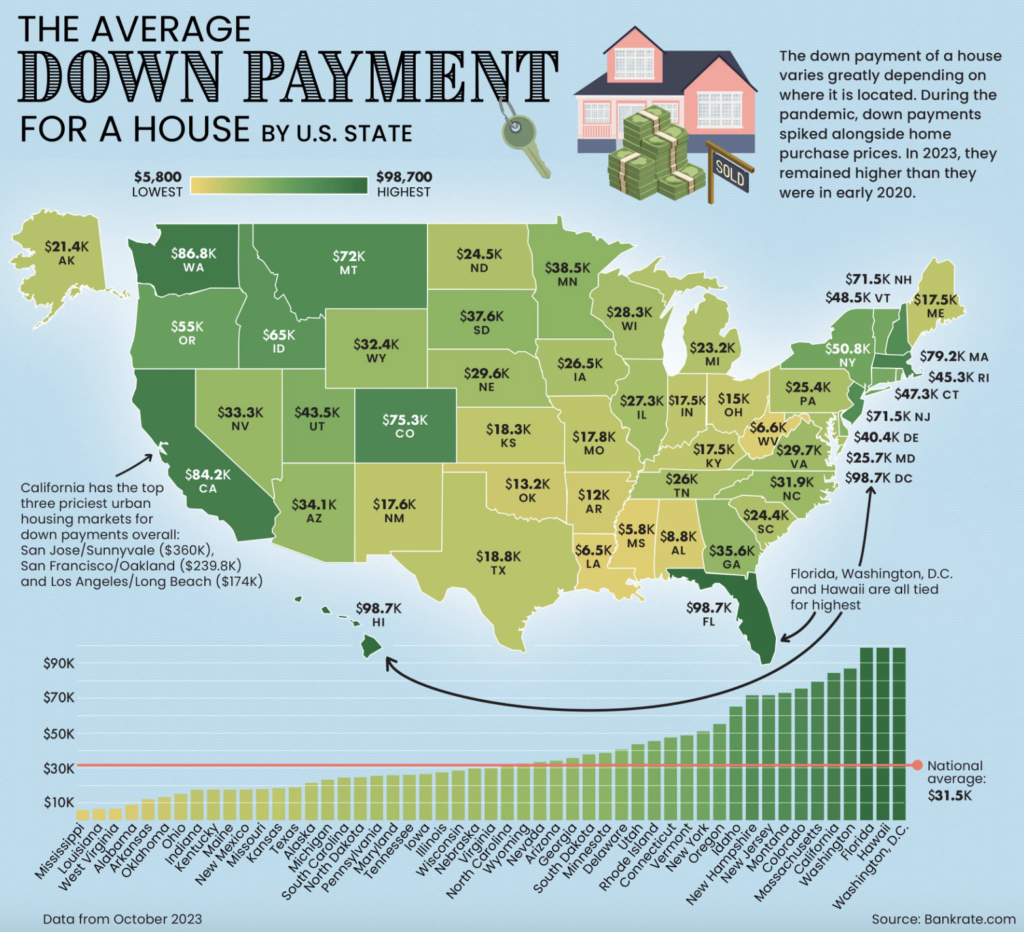Report on the State of the Housing Market: How We Got Here, Current Issues at Hand, and Looking Ahead at What’s to Come

Over the past several years, impacts from economic and societal changes have resulted in the housing market shifting significantly in many areas across the country. Across the U.S., buyers, sellers, renters, real estate agents, and financiers alike have faced many challenges trying to keep up with the changing landscape. In short, by the end of 2023, home prices rose to a near-record high, there was a shortage of 7.3 million affordable rental homes, and housing cost burdens for both owners and renters reached their highest levels in years.
Assessing the Lasting Impacts of the COVID-19 Pandemic
The COVID-19 pandemic drastically impacted the housing market, as many sought real estate outside of crowded urban city centers. As many companies were transitioning to remote work, people were able to move to more affordable and spacious areas. This caused states like South Carolina, Texas, and Idaho to experience population increases, and more metropolitan areas like New York and California to experience a decrease in population. As many people were forced to stay at home, families were also looking for larger houses, with more room to work and attend online classes from home.
During the pandemic, as many companies were forced to close and many employees were left without income, there was a big fear of a pandemic-induced recession. To combat this, the Federal Reserve provided stimulus checks and low mortgages and interest rates to encourage spending and commerce. Mortgage rates dropped throughout the pandemic and reached a record low in January of 2021 at 2.65 percent. This made it an extremely affordable time for buyers to make the move out of urban centers and into larger homes, and a profitable time to work in real estate.
In a normal time, when there is a high demand for new homes or a sudden influx of people to a new area, there would be construction teams readily available to build new neighborhoods or apartments. However, during the pandemic, there were labor and supply shortages caused by illness or by heeding necessary social distancing and quarantine requirements. This caused many housing development projects to be delayed or canceled entirely. Additionally, there were not as many homeowners or renters wanting to make a move amidst the lockdowns and fears of exposure to COVID-19. This contributed to many real estate markets having a larger demand for available homes than they were able to supply, as seen in Figure 1. From the start of 2020 to the end of 2022, the median home sales price rose from $329,000 to $479,500, which is a 46 percent increase.
Figure 1: Active Inventory and Estimated Active Buyers

The State of the Market Post-Pandemic
In 2023, the US housing market experienced a mix of declining and rising home prices across different regions. Affordability challenges persisted due to low inventory and pent-up demand, contributing to higher prices. Overall, as the year progressed, mortgage rates began to rise and home prices decreased. The median home sales price dropped 4 percent alone from the third quarter of 2023 to the fourth quarter of 2023, going from $435,400 to $417,700.
Several factors contributed to the housing market fluctuations and changes, such as shifts in economic conditions, government policies, and consumer sentiment. The ongoing recovery from the pandemic-induced economic downturn played a significant role, with employment levels and income growth affecting consumers’ ability and willingness to purchase homes. Additionally, changes in immigration patterns and household demographics impacted housing demand and supply dynamics. Government interventions, such as changes in tax policies and regulatory measures, also influence market behavior. Furthermore, psychological factors, including buyer and seller confidence, played a crucial role in shaping market trends. These multifaceted influences underscore the complexity of the housing market and highlight the need for adaptive strategies to navigate its evolving landscape.
National Shortage of Affordable Housing
The main issue that came to the forefront in the housing market throughout 2023 was a national shortage of affordable housing, for both renters and homebuyers alike. During the pandemic, as many people were facing layoffs and job insecurity, there were several different efforts made to help keep Americans housed, such as eviction moratoriums and emergency rental assistance programs. However, many of these programs ended throughout 2022, as the country began to recover from the effects of the pandemic. This left many people without enough financial resources to keep up with the record-high housing market prices. The shortage of affordable housing is so significant that the National Low-Income Housing Coalition found that per every 100 low-income families, there are on average only 33 affordable and available rental options. Nationwide, that leaves a shortage of 7 million affordable rental options for low-income families. From January 2022 to January 2023, the number of people experiencing homelessness jumped from 71,000 to 653,100, which is the largest recorded single-year increase.
Where Does the Market Stand Today
Unfortunately, the United States simply lacks housing availability compared to the high demand, which makes the average housing costs higher. In 2021, the typical monthly payment on a median home was $1,700, while today it stands at about $2,600. Even with better mortgage rates, this could end up just increasing the demand of buyers and eventually, the housing price. However, home buyers could benefit from lower rates in markets with more ample supply.
A recent survey among housing specialists provides valuable perspectives on the forthcoming trends in the housing market. It anticipates a transition from the rapid growth experienced in 2023 to a more restrained pace throughout 2024 and 2025. The projected deceleration, with expected growth rates of 2.4% and 2.7% in 2024 and 2025, respectively, contrasts notably with the previous year’s anticipated surge of 5.9%.
Despite this, year-over-year home appreciation continued to increase, and the second quarter of 2024 was expected to see a rise in demand. Sellers have been advised to price their homes realistically based on current market conditions. While residential building permits were anticipated to decline, mortgage rates were projected to decrease, potentially stimulating the housing market gradually. Notably, Atlanta emerged as a housing market to watch in 2023 due to its affordability, population growth, and robust job market. It’s essential to consider that the housing market is influenced by various factors that can evolve.
Empowering Homeownership: Strategies for Success in Today’s Housing Market
A heartening trend has emerged recently, where friends are joining forces to pursue homeownership together, particularly in light of soaring housing prices. In 2023, co-ownership rates among non-romantic partners saw a notable increase of 21.1 percent. While this non-traditional approach may not appeal to everyone, it has significantly expanded the accessibility of homeownership in today’s challenging housing market.
For those seeking a more conventional home-buying journey, there are several steps you can take to ensure you secure the most affordable deal possible.
- Credit and Rates: Given the high home prices, guaranteeing the best mortgage rate is paramount. Start by bolstering your credit standing to
improve your chances of qualifying for favorable rates. Mortgage lenders scrutinize credit scores when determining their rates, so it’s essential to begin preparing now.
- Customized Plans and Advice: If you’re a first-time homebuyer, tap into the resources and support available through your bank and potential homebuyer programs. For instance, Rocket Mortgage offers tailored programs, including assistance with down payments, closing costs, and educational resources to guide you
through the process. - Start Preparing Now: Predicting the ideal home purchase time can be challenging, so it’s wise to start planning and saving as early as possible. Research your options and determine the timing that aligns with your financial goals. Build your savings account to cove
r expenses like down payments and moving costs.
While the national average down payment may seem daunting at $31,500, committing to saving $1312.50 per month can accumulate enough funds in just two years, easing the financial burden of homeownership.
Figure 2: Average Down Payment For A House by U.S. State

Navigating the Housing Market Maze
The state of the housing market reflects a complex interplay of economic, societal, and governmental factors. Over recent years, we’ve witnessed significant shifts driven by the aftermath of the COVID-19 pandemic, including changes in population dynamics, work-from-home trends, and unprecedented interventions from the Federal Reserve. These shifts have contributed to a housing market marked by soaring prices, dwindling affordability, and a pronounced nationwide shortage of affordable housing options.
The challenges posed by the pandemic-induced economic downturn have underscored the need for adaptive strategies to navigate the evolving landscape of the housing market. Despite projections of a more restrained pace of growth in the coming years, significant opportunities and challenges lie ahead. Empowering homeownership remains a central theme, with innovative approaches such as co-ownership among non-romantic partners offering newfound accessibility amidst rising prices.
As we look ahead, it’s crucial for stakeholders—from buyers and sellers to policymakers and financiers—to remain vigilant and proactive in addressing the ongoing issues facing the housing market. Initiatives aimed at bolstering affordability, increasing supply, and providing support for first-time homebuyers will be essential in shaping the future trajectory of housing in the United States. By leveraging available resources, planning strategically, and fostering collaboration, we can work towards a housing market that is not only resilient but also inclusive and sustainable for all.
For more financial tips, industry news, and marketing strategies, check out our other articles here.
Like what you're reading?
Sign up for our Financial Experience Newsletter.
